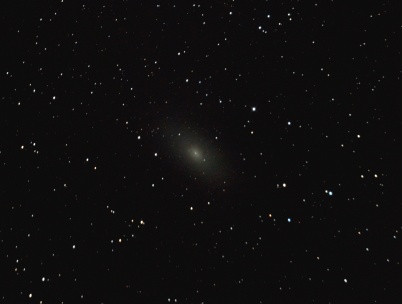

The Local Group
Our Milky Way's home in the sky is "The Local Group". (Astronomers should conduct a re-naming contest.) It is composed of a trio of galaxies and about 50 dwarf galaxies. The Milky Way's big brother is the Andromeda Galaxy (M31) with more than twice as many stars and 25% more mass. The third galaxy is the Triangulum Galaxy or Messier Object 33 with half the radius and one tenth the mass of the Milky Way. Two major satellites of the Milky Way grace the skies of the southern hemisphere -- the Large and Small Magellanic Clouds. The Milky way has at least 12 other satellite galaxies. Andromeda has at least 24 satellites, two of which are Messier Objects -- M32 and M110.
 |
 |
|
| Andromeda Galaxy M31 (Rick Whitten) | Triangulum Galaxy M33 (Rick Whitten) |
It's a small group compared to the Virgo Cluster with about 2,000 galaxies or the Coma Cluster with more than 1,000 galaxies, but our galactic neighborhood still has its share of mysteries and oddities. For example, most large galaxies have super massive black holes anchoring their centers. Andromeda has a 100 million solar mass monster at it center. The Milky Way has a 4.1 million solar mass black hole. Why is Andromeda's 25 times more massive given that the two galaxies are almost the same size? The Triangulum galaxy may not have a central black hole at all, or if it does, it must be less than 1,500 solar masses.
 |
 |
|
| M32 (Rick Whitten) | NGC 147 (Rick Whitten) |
But M32 gets the oddball prize for black holes. It has one 400th the mass of Andromeda, yet it has a super massive black hole of 2.4 million solar masses -- half as massive as the black hole at the center of our own galaxy. It seems that M32 was a much larger galaxy, but was been eaten by Andromeda 200 million years ago, leaving only its core in tact. SagDEG, the Milky Way's closest companion, has apparently been eaten by the Milky Way and may have contributed to the development of the Milky Way's spiral structure. The globular cluster M54 belongs to SagDEG and resides near its core. But SagDEG doesn't have a supermassive black hole even though it has 10 times the mass of M32. So why do some galaxies have supermassive black holes and others don't? It doesn't seem to be directly correlated to size.
| Galaxy | Mass (solar masses) | # Stars | Diameter | Distance | Black Hole (solar masses) | Notes |
|---|---|---|---|---|---|---|
| Andromeda Galaxy | 1.2 trillion | 1 trillion stars | 140,000 ly | 2.54 million ly | 100 million | Spiral Galaxy (possibly barred) |
| Milky Way | 1.0 trillion | 400 billion stars | 120,000 ly | - | 4.1 million | Barred Spiral Galaxy |
| Triangulum Galaxy | 60 billion | 40 billion stars | 50,000 ly | 2.8 million ly | < 1,500 | Unbarred Spiral Galaxy |
| Large Magellanic Cloud | 10 billion | 10 billion stars | 17,000 ly | 163,000 ly | Dwarf Irregular, Milky Way Satellite | |
| Messier 110 | 9 billion | 15,000 ly | 2.7 million ly | Dwarf Elliptical, Andromeda Satellite | ||
| Small Magellanic Cloud | 7 billion | 2 billion stars | 7,000 ly | 200,000 ly | Dwarf Irregular, Milky Way Satellite | |
| Messier 32 | 3 billion | 8,000 ly | 2.49 million ly | 2.4 million | Dwarf Elliptical,Andromeda Satellite | |
| NGC 147 | ~200 million | 2.05 million ly | Dwarf Elliptical,Andromeda Satellite | |||
| NGC 185 | ~200 million | 2.53 million ly | Dwarf Elliptical,Andromeda Satellite Active Galactic Nucleus? - Type 2 Seyfert |
|||
| Can Maj Dwarf Galaxy | 1 billion | 42,000 ly | Closest to the Earth | |||
| Sag Dwarf Elliptical Galaxy | 30 billion | 10,000 ly | 50,000 ly | Closest Galaxy to Milky Way's Center | ||
| Sag Dwarf Irregular Galaxy | 45 million | 3,600 ly | 3.4 million ly | Most distant galaxy in the local group | ||
| IC 10 | 30 million | 5,000 ly | 2.2 million ly | Dwarf Irregular, Starburst Galaxy |
 |
 |
|
| NGC 185 (Rick Whitten) | M110 (Rick Whitten) |
The structure of our own galaxy has been difficult to decipher because we are stuck in the middle of it. Dust and interstellar gas blocks our view of the center in visible light. The other two large members of the group are clearly visible, but the majority of main sequence stars (class M) are individually invisible to even the Hubble telescope at their distances. So, in a sense, the Milky Way is too close, and the other closest galaxies are too far away. Yet we base our ideas about distant galaxies on what we know about our own neighborhood.